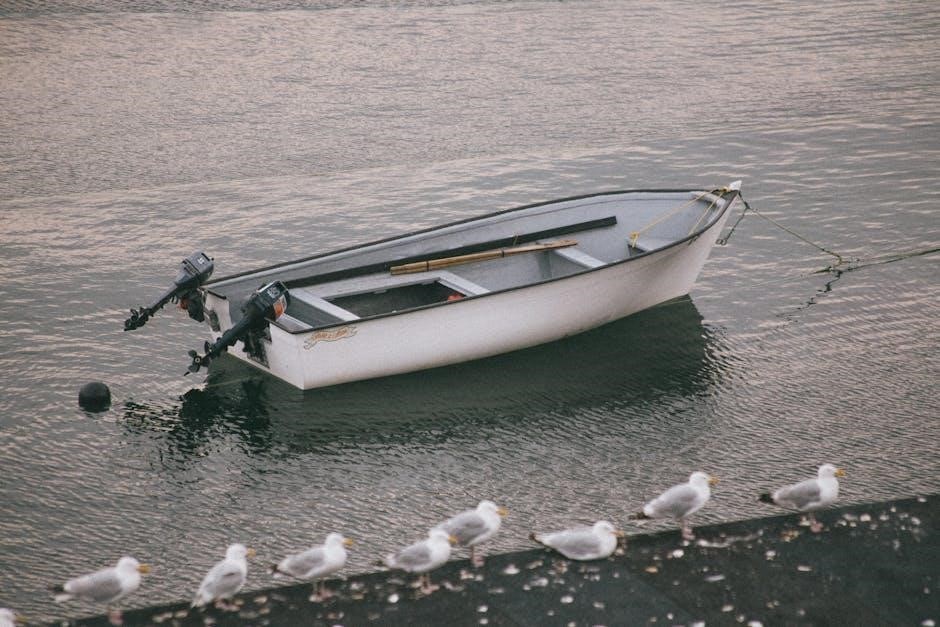Discover practical DIY solutions with outboard motor stand plans in PDF format, perfect for securely storing or maintaining your motor. These detailed guides offer easy-to-follow instructions and material lists for a sturdy, reliable setup tailored to your needs.
What is an Outboard Motor Stand?
An outboard motor stand is a sturdy structure designed to securely hold an outboard motor when it’s not attached to a boat. It provides a stable base for storage, maintenance, or transportation. These stands are typically built from durable materials like wood or metal and are customizable to fit various motor sizes. They often feature adjustable supports to accommodate different motor configurations. DIY plans, such as those found in PDF formats, offer step-by-step guides to construct these stands, ensuring they are both functional and cost-effective. A well-built stand protects the motor from damage and simplifies tasks like oil changes or winterization.
Why Use an Outboard Motor Stand?
An outboard motor stand is essential for safe and efficient storage, maintenance, and transportation of your motor. It provides a stable base, preventing damage and tipping, while keeping the motor off the ground to protect it from corrosion and pests. Using a stand makes routine tasks like oil changes, propeller inspections, and winterization easier and safer. It also allows for better organization in your garage or storage space. Portable stands enable convenient movement of the motor, reducing strain during handling. Additionally, a stand ensures the motor remains secure, preventing accidental damage or theft. Overall, it’s a practical solution for any boat owner looking to maintain their motor effectively and extend its lifespan.
Benefits of Using a Stand for Your Outboard Motor
Using a stand for your outboard motor offers numerous benefits, including enhanced stability and protection. It prevents the motor from tipping over, reducing the risk of damage during storage or maintenance. A stand also elevates the motor, shielding it from ground moisture and potential corrosion. This setup makes routine tasks like oil changes, winterization, and propeller inspections more accessible and efficient. Additionally, a stand can improve space utilization in your garage or storage area. Portability features allow easy transportation, while customizable designs can accommodate different motor sizes. Overall, a stand is a practical investment that extends the motor’s lifespan and simplifies ownership, ensuring your outboard remains in optimal condition for years to come.

Design and Construction Basics
Designing an outboard motor stand involves selecting durable materials and ensuring structural integrity. Plans often include measurements for a frame that supports the motor securely, providing stability and easy access for maintenance. The construction process typically starts with cutting and assembling the frame, followed by adding support brackets and leveling features. Ensuring the stand is sturdy and can handle the motor’s weight is crucial. Many DIY plans recommend using materials like steel or heavy-duty wood for longevity. Proper assembly and alignment are key to creating a reliable stand that protects your motor and simplifies upkeep. Detailed PDF guides are available online to help you get started.
Key Considerations for Building a Motor Stand
When building an outboard motor stand, prioritize stability, weight capacity, and ease of use. Ensure the design accommodates your motor’s size and weight, with a sturdy frame to prevent tipping. Consider the material’s durability, such as steel or treated wood, to withstand outdoor conditions. Incorporate features like adjustable height or wheels for portability. Proper weight distribution is critical to maintain balance and prevent damage to the motor. Safety should always come first, so double-check all welds and connections. Optional features like a mounting bracket or storage tray can enhance functionality. Refer to detailed PDF plans for precise measurements and assembly tips to ensure a professional-grade result.
Materials Needed for an Outboard Motor Stand
To build a sturdy outboard motor stand, you’ll need durable materials such as 2×4 lumber, steel tubing, or treated wood for outdoor use. Hardware like screws, bolts, and washers are essential for assembly. Consider adding wheels for portability, using metal plates for extra stability, and protective coatings like paint or varnish to prevent rust or rot. Scrap wood can also be repurposed for a cost-effective solution. Ensure all materials are weather-resistant to withstand outdoor conditions. A detailed PDF guide will provide specific measurements and quantities for each component, helping you prepare everything needed before starting the project.
Tools Required for the Project
Essential tools for building an outboard motor stand include a saw for cutting lumber, a drill for screwing parts together, and a wrench or socket set for tightening bolts. Sandpaper will help smooth rough edges, while a measuring tape ensures accurate cuts. If using metal, a welder may be necessary for durability. For portability, a wheel kit can be added, requiring basic hand tools. A PDF guide will list all tools needed, helping you prepare in advance. Proper tools ensure a safe and efficient build, resulting in a sturdy stand for your motor.

Safety Tips and Precautions
Ensure the stand is stable on a level surface and securely fasten the motor to prevent tipping. Always wear protective gear and follow proper lifting techniques to avoid injury.
Safety Guidelines for Building and Using the Stand
When building an outboard motor stand, always wear protective gear like gloves and safety glasses. Ensure the workspace is well-ventilated and free from flammable materials. Use proper tools and follow instructions carefully to avoid accidents. Before placing the motor on the stand, check the stand’s stability and weight capacity. Secure the motor firmly to prevent any movement during maintenance or storage. Regularly inspect the stand for signs of wear or damage, addressing issues promptly to maintain safety. Keep the area around the stand clear to prevent tripping hazards. Adhere to these guidelines to ensure safe and effective use of your outboard motor stand.
Weight Distribution and Stability of the Stand
A sturdy outboard motor stand requires careful attention to weight distribution and stability to prevent tipping or collapse. Ensure the stand’s base is wide and low to the ground, with evenly spaced legs for balance. Use durable materials like steel or heavy-duty wood to support the motor’s weight. Level the stand on a firm surface to avoid wobbling, and consider adding adjustable feet for uneven ground. Reinforce the frame with crossbeams or brackets to distribute weight evenly. Properly secure the motor to the stand using straps or brackets to prevent movement. These design features ensure the stand remains stable, protecting both the motor and the surrounding area from potential damage.
Securing the Motor to the Stand
Properly securing your outboard motor to the stand is essential for safety and stability. Use high-quality straps or brackets to fasten the motor firmly to the stand, ensuring no movement during storage or transport. Tighten all bolts and fasteners to prevent loosening over time. Consider adding a locking mechanism for added security against theft. Ensure the stand is designed to accommodate the motor’s weight and size, and always follow the manufacturer’s guidelines for securing the motor. Regularly inspect the straps and connections to ensure they remain in good condition. A well-secured motor on a sturdy stand minimizes risks of damage or accidents.

Step-by-Step Construction Guide
Follow detailed PDF plans to build a sturdy outboard motor stand. Start with cutting materials, then assemble the frame, and finish with securing brackets for stability.
Planning and Measuring the Stand
Planning and measuring are crucial for building a functional outboard motor stand. Start by determining the motor’s dimensions to ensure proper fit and support. Use PDF plans as a guide to outline the stand’s dimensions, ensuring stability and balance. Measure twice to confirm accuracy. Consider the motor’s weight and select materials that can handle the load. Ensure the stand’s height allows easy access for maintenance. Mark all cut points clearly before proceeding. Proper planning prevents structural issues and ensures the stand meets your needs. Follow detailed instructions from PDF plans to achieve precise measurements and a sturdy design. This step sets the foundation for a successful build.
Cutting and Preparing the Materials
Cutting and preparing materials is a critical step in building your outboard motor stand. Begin by gathering all required materials, such as 2×4 lumber, screws, and metal brackets. Use a saw to cut the wood according to the measurements outlined in your PDF plans. Sand the cut edges to ensure smooth surfaces. Drill holes for bolts or screws as specified. Organize the pieces to ensure everything fits together seamlessly. Double-check your cuts for accuracy before proceeding. Proper preparation ensures a sturdy and durable stand. Follow the plans carefully to avoid errors and save time during assembly. This step lays the groundwork for a successful build.
Assembling the Stand Frame
Assembling the stand frame requires precision and care. Begin by connecting the base pieces using screws or bolts, ensuring a sturdy foundation. Attach the vertical supports to the base, aligning them with the pre-drilled holes. Use a level to confirm the frame is even and plumb. Next, secure the horizontal crossbars to add stability and support. Tighten all connections firmly but avoid overtightening. Follow the PDF plans for the correct order of assembly. If wheels are included, attach them to the base for portability. Double-check all joints for strength and alignment. A well-assembled frame ensures the stand can safely hold the weight of the outboard motor. Proceed methodically to achieve a robust structure.
Adding Support and Stability Features
Enhance your stand’s durability by incorporating additional support and stability features. Install crossbars or brackets to distribute weight evenly and prevent wobbling. Use metal or wooden reinforcements to strengthen weak points. Anti-vibration pads can be added to minimize motor movement. Ensure all bolts and screws are tightened securely. Consider adding adjustable supports to accommodate different motor sizes. For extra stability, attach non-slip feet to the base. These features ensure the stand remains balanced and level, protecting your motor from damage. Follow the PDF plans for specific designs, such as reinforced corners or locking mechanisms, to maximize stability and safety.

Storage and Maintenance
Properly store your outboard motor on a stand to protect it from damage. Regularly inspect and maintain the stand and motor. Winterize the motor for long-term storage.
How to Properly Store Your Outboard Motor on the Stand
Proper storage of your outboard motor on a stand ensures protection from damage and extends its lifespan. Begin by placing the motor securely on the stand, ensuring it is level and stable. Use the provided supports or brackets to hold the motor in place. Cover the motor with a waterproof cover to shield it from dust, moisture, and pests. Store the stand in a dry, well-ventilated area, away from direct sunlight or extreme temperatures. Regularly inspect the stand for any signs of wear or damage. For long-term storage, consider winterizing the motor by draining fluids and applying a protective coating to metal parts.
Maintenance Tips for the Stand and Motor
Regular maintenance is crucial to ensure the longevity of both the outboard motor and its stand. Inspect the stand for rust, corrosion, or damage, especially after exposure to saltwater. Apply a rust-inhibiting coating to metal parts and tighten any loose bolts or screws. For the motor, check for any signs of wear, such as cracked hoses or worn belts. Lubricate moving parts and ensure all electrical connections are secure. Clean the motor thoroughly, removing any debris or grime that may accumulate. Store the motor in a dry, well-ventilated area to prevent moisture buildup. Follow the manufacturer’s guidelines for routine service and parts replacement to maintain optimal performance.
Winterizing Your Outboard Motor
Winterizing your outboard motor is essential to protect it from cold weather damage and ensure it runs smoothly in the next season. Start by draining the fuel tank and running the motor with a fuel stabilizer to prevent ethanol-related issues. Flush the cooling system with freshwater to remove any salt or debris. Apply fogging oil to the cylinders to prevent rust and corrosion. Disconnect the battery and store it in a cool, dry place. Cover the motor with a high-quality waterproof cover to shield it from dust and moisture. Store the motor on a sturdy stand to maintain stability and prevent warping. Follow the manufacturer’s specific winterization instructions for optimal protection.

Customization and Upgrades
Elevate your outboard motor stand’s functionality with customization options like adding wheels for portability or modifying the design to fit various motor sizes. Explore optional upgrades for enhanced convenience and durability.
Adding Wheels for Portability
Enhance your outboard motor stand’s versatility by incorporating wheels, making it easier to move the motor around your workshop or storage area. This modification ensures smooth transportation, reducing strain and effort. Use durable, heavy-duty wheels that can support the weight of your motor. Ensure the wheels are securely attached to the stand’s frame for stability. Consider adding a locking mechanism to prevent unintended movement. Detailed plans in PDF format often include specific measurements and hardware recommendations for this upgrade. By adding wheels, you can effortlessly relocate your motor, making maintenance and storage more convenient than ever.
Customizing the Stand for Different Motor Sizes

Ensure your outboard motor stand accommodates various motor sizes by incorporating adjustable features. Use sliding brackets or variable-height supports to fit motors of different dimensions. For smaller motors, like a 9.9 Yamaha, a compact design suffices, while larger models may require extended frames. Consider using universal clamps or mounts to secure motors of varying widths. Materials like steel or sturdy wood can be adapted to different sizes. Detailed PDF plans often include measurements and tips for customization, ensuring your stand remains versatile and functional. This approach allows you to support multiple motors, making the stand a practical investment for any boating enthusiast.
Optional Features to Enhance Functionality
Add wheels or casters for easy portability, making it simple to move the stand around your workshop or storage area. Include storage compartments or shelves to keep maintenance tools and supplies within reach. A height-adjustable feature allows for versatile use, accommodating different maintenance tasks or user preferences. Consider adding a mounting system for accessories like fuel tanks or propellers. These enhancements improve practicality and convenience, ensuring your stand meets all your needs. Detailed PDF plans often highlight these optional features, helping you create a stand that is both functional and tailored to your specific requirements.

Troubleshooting Common Issues
Address wobbling or instability by tightening bolts or adjusting the stand’s balance. Check for corrosion and secure loose parts. Ensure proper weight distribution for stability.
Common Problems with DIY Stands
One of the most frequent issues with DIY outboard motor stands is instability, often due to improper weight distribution or uneven surfaces. Many builders overlook the importance of securing the motor tightly, leading to wobbling during maintenance or storage. Additionally, using low-quality materials can result in a stand that corrodes over time or fails to support the motor’s weight adequately. Another common mistake is not accounting for the motor’s exact dimensions, which can cause the stand to be too small or poorly fitted. Addressing these issues requires careful planning and adherence to the provided PDF plans to ensure durability and reliability.
How to Fix a Wobbly or Unstable Stand
To address a wobbly or unstable outboard motor stand, start by assessing the cause. Check for loose bolts or screws and tighten them firmly. Ensure the stand is placed on a level surface; if not, use adjustable feet or shims to stabilize it. Reinforce the frame by adding diagonal braces or supports, which can enhance structural integrity. Consider upgrading to sturdier materials, such as thicker wood or metal, to prevent flexing. If wheels are installed, switch to larger, heavy-duty options or locking casters for better stability. Finally, verify that the motor is properly balanced and secured to the stand to prevent movement. These adjustments will help restore stability and ensure safe use.
Addressing Corrosion and Rust on the Stand
To combat corrosion and rust on your outboard motor stand, start by inspecting the metal components for signs of damage. Use sandpaper or a wire brush to remove any rust or flaking paint; Apply a rust-inhibiting primer to the affected areas before painting with a durable, marine-grade paint. For added protection, consider applying a marine epoxy or anti-corrosive coating. Regularly cleaning the stand and storing it in a dry, well-ventilated area can prevent future rust formation. For severe cases, replace corroded parts with stainless steel or galvanized alternatives. Routine maintenance ensures the stand remains sturdy and reliable for years of use.

Cost-Effective Solutions
Building an outboard motor stand on a budget is achievable by repurposing scrap materials and utilizing affordable tools. DIY projects save costs and ensure durability for motor maintenance.
Building a Stand on a Budget
Constructing an outboard motor stand on a budget is feasible by using recycled materials like scrap wood or metal. Many DIY enthusiasts repurpose old furniture or pallets to minimize costs. Simple tools such as drills, saws, and wrenches are often sufficient for the project. Online plans and tutorials provide step-by-step guidance, eliminating the need for expensive professional help. By sourcing materials creatively and following cost-effective designs, you can build a sturdy and functional stand without breaking the bank. This approach not only saves money but also ensures the stand is tailored to your specific needs.
Repurposing Materials for the Stand
Repurposing materials is a cost-effective and eco-friendly way to build an outboard motor stand. Consider using scrap wood, metal frames, or even plastic containers. Old furniture, like pallets or crates, can be disassembled and reused. Thrift stores and garage sales often have affordable options. Ensure the materials are durable and suitable for the motor’s weight. With creativity, you can create a sturdy stand while reducing waste and saving money. This approach also allows for customization, making the stand fit your specific needs. Detailed plans in PDF format often include tips for repurposing materials effectively.
Comparing DIY vs. Pre-Built Stands
When deciding between DIY and pre-built stands, consider cost, convenience, and customization. DIY stands, like those from PDF plans, offer affordability and the ability to tailor designs to your motor’s size and needs. They often use materials like scrap wood or 2×4 lumber, making them budget-friendly. Pre-built stands, however, provide instant solutions with consistent quality and durability. They are ideal for those short on time or unsure of their DIY skills. Both options have merits, but DIY stands allow for creativity and cost savings, while pre-built stands ensure reliability and ease of use. Choose based on your priorities and available resources.

Environmental Considerations
Using eco-friendly materials and sustainable practices ensures your outboard motor stand is environmentally responsible, reducing waste and promoting energy efficiency in motor maintenance and storage.
Eco-Friendly Materials for the Stand
Using eco-friendly materials for your outboard motor stand ensures sustainability and reduces environmental impact. Opt for reclaimed or sustainably sourced wood, such as cedar or pine, which are durable and naturally resistant to rot. Aluminum and recycled steel are excellent alternatives, offering strength and corrosion resistance while minimizing waste. Consider repurposing materials like pallet wood or old furniture to create a budget-friendly and environmentally conscious stand. Additionally, use non-toxic finishes or sealants to protect the stand without harming the environment. These choices not only support eco-friendly practices but also ensure your stand is long-lasting and reliable for storing or maintaining your outboard motor.
Proper Disposal of Old Motors and Stands
Proper disposal of old outboard motors and stands is crucial to minimize environmental impact. Always follow local regulations and guidelines for hazardous waste disposal, as motors may contain harmful materials like oil, fuel, and heavy metals. Drain all fluids and safely dispose of them at designated facilities. Recycling is a viable option for metal components, reducing landfill waste. Consider donating functional parts or repurposing materials for new projects. Never discard old motors or stands in landfills without proper preparation. Ensure environmentally responsible disposal to protect ecosystems and comply with environmental laws. This approach promotes sustainability and reduces pollution risks.
Energy Efficiency in Motor Maintenance
Maintaining your outboard motor stands and engines efficiently ensures optimal performance and energy conservation. Regular tune-ups and oil changes prevent excessive fuel consumption and emissions. Use eco-friendly lubricants and fuels to reduce environmental impact. Proper storage on a well-designed stand minimizes wear and tear, extending the motor’s lifespan. Regularly cleaning and inspecting the motor ensures it runs smoothly, reducing energy waste. Follow manufacturer guidelines for maintenance to optimize energy use. By adopting these practices, you not only save fuel but also contribute to a greener environment. Efficient motor maintenance is essential for both performance and sustainability, making it a priority for responsible boat owners.
Download outboard motor stand plans in PDF for a cost-effective, sturdy solution. These easy-to-follow guides ensure secure storage and maintenance, making your project straightforward and efficient.
Outboard motor stand plans in PDF offer a cost-effective solution for securely storing and maintaining your motor. These detailed guides provide easy-to-follow instructions, material lists, and design tips to ensure a sturdy setup. By using scrap materials or repurposing items, you can build a stand on a budget while ensuring stability and safety. DIY tutorials and online resources make the project accessible for all skill levels. Proper construction ensures your motor remains protected and easy to service. Downloading these plans allows you to create a reliable stand tailored to your needs, enhancing both functionality and convenience for boat maintenance and storage.
Final Tips for a Successful Project
Ensure success by following detailed PDF plans for your outboard motor stand. Measure carefully and use durable materials like 2×4 lumber for stability. Consider adding wheels for portability and customizing the stand to fit your motor’s size and weight. Double-check all measurements and ensure the stand is level for safety. Test the stand with the motor before long-term storage. For added convenience, include features like storage trays or hooks. Always prioritize stability to prevent accidents. If unsure, consult additional tutorials or forums for guidance. With proper planning and execution, your DIY stand will provide reliable support and protection for your outboard motor.
Where to Find Additional Resources and Plans
For comprehensive guides, download outboard motor stand plans PDF from reputable DIY websites or forums. Platforms like Pinterest offer inspiration and tutorials, while websites like Ko-fi provide affordable downloadable plans. Check online marketplaces or marine enthusiast communities for user-shared designs. Many creators offer step-by-step videos on YouTube, detailing materials and assembly. Additionally, repurpose materials like scrap wood or old hand trucks to build cost-effective stands. Always verify plans for compatibility with your motor’s size and weight. For expert advice, join forums or groups dedicated to boat maintenance and DIY projects. These resources ensure you find the perfect plan to suit your needs.